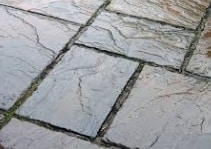 A slab is a smooth, thin stone that is used in construction . With the slabs the floor is paved, roofs are developed and walls are covered, for example.
A slab is a smooth, thin stone that is used in construction . With the slabs the floor is paved, roofs are developed and walls are covered, for example.
The slabs, therefore, are construction materials . Beyond their use in buildings, since ancient times they have been used to create different types of structures .
Traps used to be built with small slabs to catch rodents or birds. In this case, the stone was placed in an almost vertical position, forming an angle with the ground. To support it, a branch or a stick was used. A bait was placed under the slab to attract the animal which, upon touching the branch, caused the stone to fall, being crushed or, at least, trapped.
Slabs were also used to wash clothes . The garments were scrubbed with soap and water against the surface to remove dirt.
Long ago, tombs used to be covered with heavy slabs, as a cover for the tomb . It was common for the name of the deceased to be engraved on the stone along with their dates of birth and death.
A hot slab , meanwhile, is used for cooking. There is a cooking method that consists of placing the slab on the fire and then arranging the food on it, which is sometimes spread with oil or lard (butter). Even the slab can later be used as a plate.
The foundation slab , finally, is a concrete plate ( concrete ) that rests on ground to distribute the loads and weight of a construction throughout the total support surface.
In this context, a plate is called a structural element that, from a geometric point of view, can be approached to another and work mainly in flexion. Unlike the sheet , the plate has a flat middle surface, while the first is curved (something that can be seen, for example, in a dome).
Concrete , on the other hand, is a composite material, since it is achieved by joining more than one to combine their properties and obtain results impossible by using only one. In this case, it is mainly a binder combined with additives, water and aggregates. It is used in the construction field.
The slab is a type of surface foundation that offers a very satisfactory result in terrain with little homogeneity , since engineers try to avoid differential settlements , the displacements or movements of the parts of a building that occur when the surface is irregular.
 Another area in which the foundation slab is very successful is land whose bearing capacity is very low. The bearing capacity is what the soil has to resist the loads applied to it.
Another area in which the foundation slab is very successful is land whose bearing capacity is very low. The bearing capacity is what the soil has to resist the loads applied to it.
There are slabs whose thickness is invariable, the simplest, while others have different thicknesses according to the arrangement of the columns and walls, the ribbed slabs .
The calculation of the foundation slab is similar to that of a roof plan, although it is necessary to reverse the direction of each effort and apply the axial and uniform loads that come from each part of the building. The beams (large beams) of the slabs must be inverted so that they are buried in the surface, so that there are no obstacles in their use but rather the result is a smooth space.
A foundation slab acts as a plate that is influenced by vertical forces on its underside that are proportional to the settlement and the ballast modulus (a magnitude that is associated with the stiffness of the surface).
